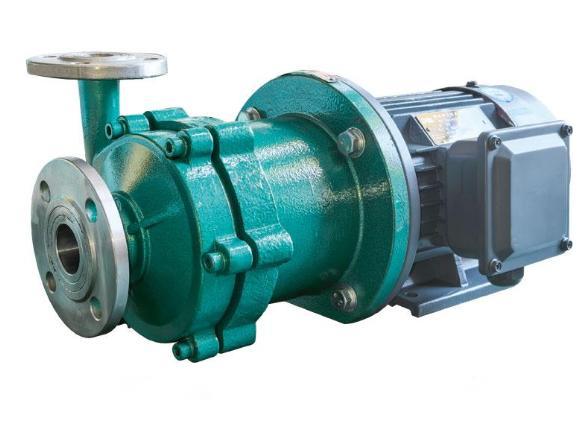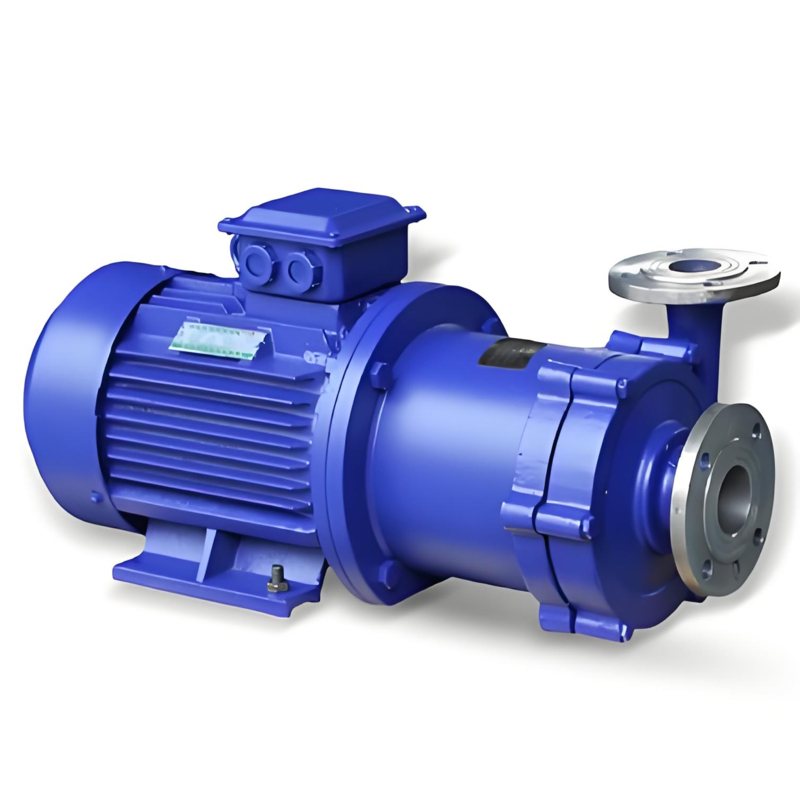Nov 09, 2024
Introduction
In the field of liquid transportation in modern industry, magnetic-drive pumps stand out with their unique designs and excellent performance. It is an innovative type of pump that utilizes the principle of magnetic coupling to achieve leak-free liquid transportation, providing an effective solution to the leakage problem of traditional pumps under special working conditions. It is widely used in industries such as chemical, pharmaceutical, and environmental protection, where high requirements for safety and sealing are imposed.
Structure of Magnetic Pumps
Pump Body And Impeller
Pump Body:
The pump body is an important outer casing part of the magnetic drive pump. Its main function is to provide a stable flow passage and accommodation space for the liquid. The selection of its material is crucial and is usually determined according to the nature of the liquid being transported. For corrosive liquids, corrosion-resistant metal materials such as stainless steel and Hastelloy are generally used, or high-performance engineering plastics such as polyvinylidene fluoride (PVDF) are adopted. The designed shape and internal flow channel structure of the pump body are carefully optimized to ensure that the liquid can flow smoothly and efficiently during the flow process, reducing energy loss and turbulence.
Impeller:
The impeller, as the core hydraulic component of the magnetic-drive pump, is directly related to the pump's performance. It is installed on the pump shaft and connected to the inner magnetic rotor. There are various types of impellers, and common ones include closed-type impellers, open-type impellers, and semi-open-type impellers. Closed-type impellers have high efficiency and stable flow, and are suitable for transporting clean liquids; open-type and semi - open - type impellers have better anti-clogging capabilities and are suitable for transporting liquids containing certain particulate impurities. During the rotation process, the impeller converts the mechanical energy input by the motor into the kinetic energy and pressure energy of the liquid, enabling the liquid to flow smoothly from the inlet to the outlet of the pump.
Magnetic Transmission Components
Inner Magnetic Rotor:
The inner magnetic rotor is one of the key components of the magnetic transmission of the magnetic-driven pump. It is coaxially connected to the impeller. The inner magnetic rotor is usually made of high-strength, high - energy - product permanent magnetic materials, such as neodymium - iron - boron (NdFeB). These permanent magnetic materials can maintain a stable magnetic field strength for a long time, ensuring the reliability of magnetic transmission. The structural design of the inner magnetic rotor needs to consider the uniformity of the magnetic field distribution and the coupling effect with the outer magnetic rotor. At the same time, it also needs to take into account its corrosion resistance and mechanical strength in the liquid, because it is directly in contact with the transported liquid or adjacent to it through the isolation sleeve.
Outer Magnetic Rotor:
The outer magnetic rotor is installed on the motor shaft, corresponding to the inner magnetic rotor, and separated by an isolation sleeve. The outer magnetic rotor is also made of permanent magnetic materials, and its magnetic field strength and pole distribution match those of the inner magnetic rotor. When the motor drives the outer magnetic rotor to rotate, the generated rotating magnetic field can penetrate the isolation sleeve and act on the inner magnetic rotor, driving the inner magnetic rotor to rotate synchronously. The design of the outer magnetic rotor needs to consider the firmness of the connection with the motor shaft and the concentricity to ensure the smoothness and high efficiency of the magnetic transmission.
Isolation Sleeve:
The isolation sleeve is the core guarantee for the magnetic-drive pump to achieve leak-free operation. It is located between the inner and outer magnetic rotors and completely isolates the liquid inside the pump from the outside. The selection of the material and thickness of the isolation sleeve is very important. On the one hand, it must have good corrosion resistance to resist the erosion of the transported liquid; on the other hand, it must have sufficient strength to withstand the internal and external pressure differences. Common isolation sleeve materials include metals (such as stainless steel) and non-metals (such as ceramics, glass-fiber-reinforced plastics, etc.). Metal isolation sleeves will generate eddy current losses in the magnetic field, affecting the magnetic transmission efficiency, but have high strength; non-metal isolation sleeves have no eddy current losses, but their strength and high-temperature resistance may be relatively weak. Therefore, a reasonable selection needs to be made according to the specific working conditions.
Bearing and Support Structure
Sliding Bearing:
Inside the magnetic-drive pump, the pump shaft is usually supported by sliding bearings. Since the transported liquid often has poor lubricity and may even be corrosive, the materials of the sliding bearings must have good wear resistance and self-lubricating properties. Commonly used materials include silicon carbide ceramics, graphite, and filled polytetrafluoroethylene. These materials can reduce wear under harsh lubrication conditions, ensure the stable rotation of the pump shaft, and extend the service life of the bearings. The design of the sliding bearings also needs to consider the fitting accuracy of the pump shaft and the load-bearing capacity to adapt to the load requirements under different working conditions.
Rolling Bearing:
Rolling bearings are mainly used to support the outer shaft of the pump, the part connected to the motor. It can effectively reduce the frictional resistance during the rotation process and improve transmission efficiency. The selection of rolling bearings needs to consider factors such as load-bearing capacity, speed range, and lubrication method. Generally, rolling bearings with good sealing performance are used, and appropriate lubricating grease is selected according to the actual working environment to ensure their long-term stable operation. In addition, there are support structures such as connecting frames, whose functions are to ensure the stable relative position between the pump body and the motor, ensure the coaxiality and perpendicularity of each component during the operation of the magnetic-drive pump, and reduce vibration and noise.
Working Principle of Magnetic-Drive Pumps
After the motor is started, the motor shaft drives the outer magnetic rotor to start rotating. The rotating magnetic field generated by the outer magnetic rotor penetrates the isolation sleeve and acts on the inner magnetic rotor. Due to the interaction of the magnetic fields, the inner magnetic rotor rotates synchronously within the isolation sleeve. The inner magnetic rotor is connected to the impeller, so the impeller also rotates. Under the action of the impeller's rotation, the liquid is sucked in from the inlet of the pump and enters between the blades of the impeller. With the high-speed rotation of the impeller, the liquid obtains kinetic energy and is thrown towards the edge of the pump body under the action of centrifugal force. In the flow passage formed by the pump body and the impeller, the kinetic energy of the liquid is gradually converted into pressure energy, and the liquid with increased pressure is discharged through the outlet of the pump. During the whole process, due to the action of magnetic transmission, the liquid inside the pump is completely isolated from the outside, and there is no leakage channel of the mechanical seal of traditional pumps, thus realizing leak-free transportation.
Characteristics of Magnetic Pumps
Leak - free Characteristic
The greatest advantage of the magnetic-drive pump lies in its leak-free performance. In many industrial occasions, such as the transportation of flammable, explosive, toxic, and harmful liquids in chemical production, or the transportation of liquid medicine with extremely high purity requirements in the pharmaceutical industry, the seal leakage of traditional pumps may cause serious safety accidents and quality problems. However, the magnetic-drive pump completely encloses the liquid inside the pump body through magnetic coupling transmission, eliminating the medium leakage caused by seal failure and effectively ensuring the safety of the production environment and product quality.
Safety and Reliability
Operational Stability:
The structural design of the magnetic-drive pump makes it have high stability during the operation process. Since there is no friction and wear at the mechanical seal and the resulting vibration and noise, the magnetic-drive pump operates more smoothly. At the same time, the magnetic coupling can maintain stable transmission during normal operation. When encountering an overload situation, such as impeller blockage or jamming, the outer magnetic rotor, and the inner magnetic rotor can relatively slip, avoiding damage to the motor and transmission components due to excessive torque, playing a certain overload protection role.
Reducing the Risk of Failure:
Without the problem of easy damage of traditional mechanical seals, the risk of failure of the magnetic-drive pump is greatly reduced. Mechanical seals are prone to leakage due to wear, aging, and corrosion during long-term operation, while the magnetic transmission components of the magnetic-drive pump have a long service life, reducing sudden failures caused by seal damage, improving the reliability and continuous operation time of the equipment, and reducing the impact of maintenance costs and downtime on production.
Simple Maintenance:
Since the magnetic-drive pump has no mechanical seals, packing seals, and other components that need to be regularly replaced and maintained, its maintenance work is relatively simple. This not only reduces the workload of maintenance personnel but also reduces the maintenance cost. In addition, the structure of the magnetic-drive pump is relatively compact, and the number of parts is relatively small, which also makes it more convenient and faster to conduct maintenance and troubleshooting, further improving the maintainability of the equipment.
Development Trends of Magnetic - Drive Pumps
With the continuous progress of science and technology, magnetic-drive pumps will develop towards higher performance and more intelligent directions in the future. In terms of materials, the research and development of new magnetic materials will further improve the magnetic transmission efficiency and reduce energy loss. At the same time, the improvement of isolation sleeve materials will make the isolation sleeve have high strength and high corrosion resistance while reducing the impact on magnetic transmission. In terms of design, optimizing the hydraulic design of the pump body and impeller will improve the efficiency and performance of the pump. In addition, with the development trend of industrial automation and intelligence, magnetic-drive pumps will be increasingly integrated into intelligent control systems, realizing functions such as remote monitoring, fault diagnosis, and automatic alarm, further improving the reliability and management efficiency in industrial production, and better meeting the strict requirements of modern industry for liquid transportation equipment.
Read More

